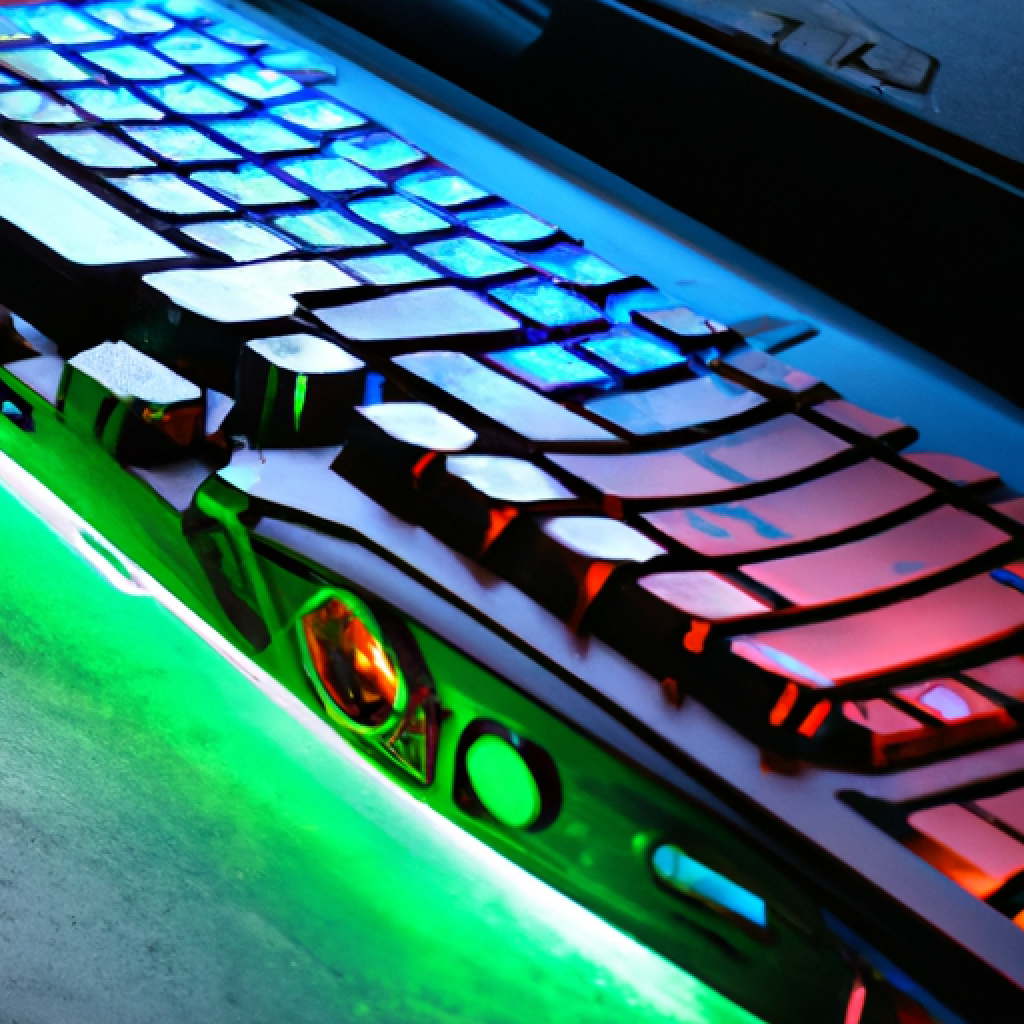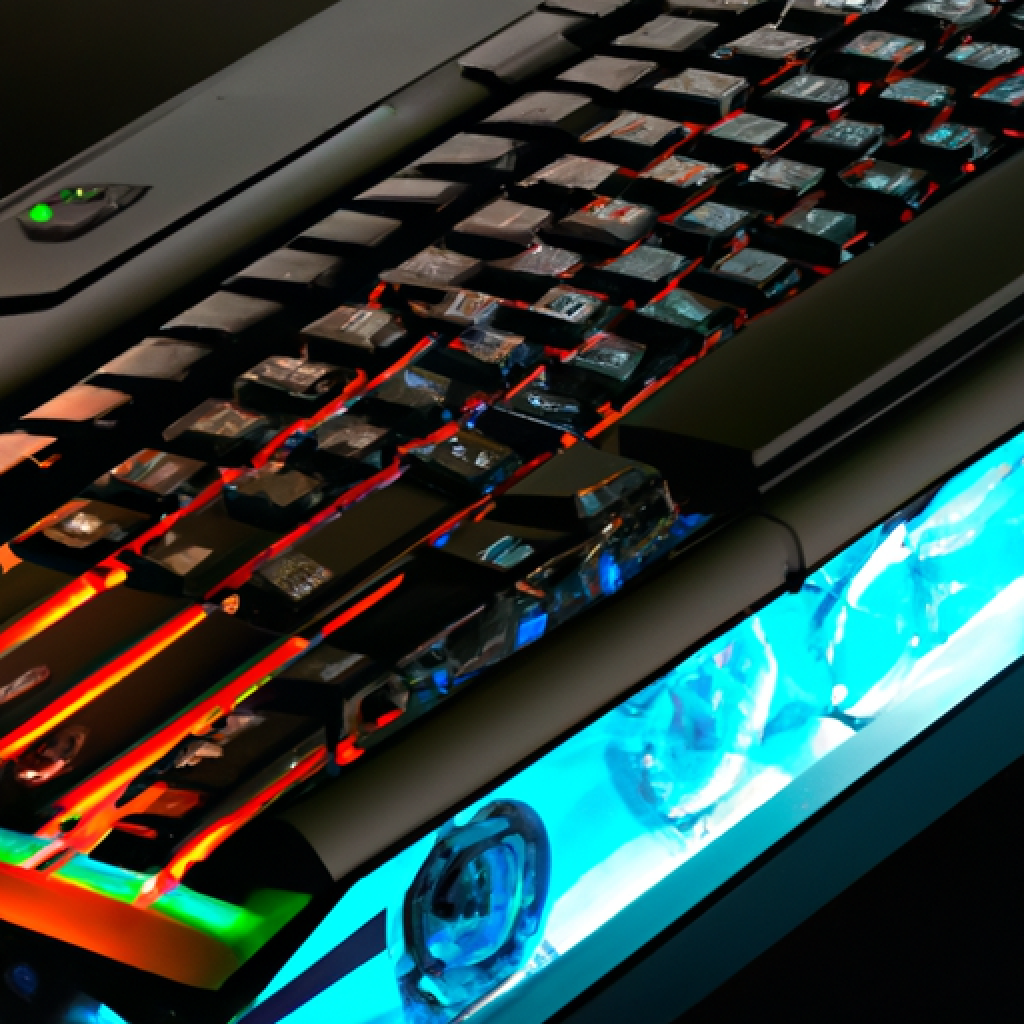How Much RAM Will Most Gamers Need In Their Laptop?

I’ve always been fascinated by the world of gaming and all the technology that goes along with it. As technology continues to advance at lightning speed, one question that frequently comes to mind is, how much RAM do gamers really need in their laptops? With games becoming more demanding in terms of graphics and performance, it’s essential to have enough RAM to handle these heavy loads. In this article, I will explore the ideal amount of RAM that most gamers should aim for in their laptops, providing insights and recommendations for a seamless gaming experience.

Understanding RAM and Its Importance in Gaming
RAM, or Random Access Memory, plays a crucial role in the world of gaming. As a gamer, I know firsthand that having sufficient RAM is necessary for a smooth and immersive gaming experience. So, what exactly is RAM, and why is it so important?
Defining RAM for gamers
In simple terms, RAM is a type of computer memory that is responsible for storing and accessing data that the CPU (Central Processing Unit) needs quickly. Unlike the permanent storage provided by a hard drive or SSD (Solid State Drive), RAM is volatile memory, which means that its contents are lost when the computer is powered off. RAM allows for faster data access, as it stores temporary files and information that the computer needs to retrieve frequently.
For gamers, RAM serves as a temporary storage space for the game’s assets, such as textures, models, and sound files. When you’re playing a game, the CPU retrieves these assets from the RAM, allowing for seamless and uninterrupted gameplay. Insufficient RAM can lead to lag, slow loading times, and even crashes during gameplay.
Role of RAM in gaming laptops
When it comes to gaming laptops, RAM plays a crucial role in determining the overall performance and handling of games. Gaming laptops are designed to provide a portable and powerful gaming experience, but without adequate RAM, they may fall short in delivering optimal performance.
In a gaming laptop, RAM enables the system to load and handle large game files efficiently. It influences the smoothness of gameplay, the speed at which levels and scenes are loaded, and the ability to multitask while gaming. Additionally, RAM also affects the performance of other system-related tasks, such as video editing, streaming, and running resource-intensive applications alongside gaming.
How RAM affects gaming performance
RAM has a direct impact on gaming performance, influencing factors such as frame rates, loading times, and overall system stability. Insufficient RAM can lead to a decrease in performance, resulting in a frustrating gaming experience.
When a game is running, RAM stores the game’s assets, information about in-game characters, and other data necessary for the game to run smoothly. With limited RAM capacity, the system may struggle to load and keep track of all the required data, resulting in stutters, frame rate drops, and longer loading times.
Having ample RAM allows the system to store and retrieve data quickly, ensuring a smooth and optimal gaming experience. It provides a buffer for the CPU, allowing it to efficiently handle the game’s demands without being overwhelmed. Thus, investing in a suitable amount of RAM is crucial for gamers who want their gaming sessions to be immersive, seamless, and free of any hiccups.
Current RAM Requirements for Popular Games
As technology advances, the requirements for RAM in popular games continue to evolve. To ensure optimal performance, it’s essential for gamers to be aware of the current RAM requirements for the games they intend to play.
RAM requirements for AAA games
AAA games, which are high-budget and heavily marketed titles, often demand significant resources from a gaming system. These games boast state-of-the-art graphics, complex gameplay mechanics, and large game worlds, which necessitate a significant amount of RAM.
On average, most AAA games released in recent years recommend a minimum of 8GB of RAM. However, for an optimal experience, it’s advisable to have at least 16GB of RAM. This ensures that the game has sufficient room to store and retrieve assets, resulting in smoother gameplay and reduced loading times.
RAM requirements for indie games
Indie games, on the other hand, are typically developed by smaller studios or independent developers, and they tend to have lower system requirements compared to AAA titles. These games often prioritize artistic design, unique gameplay mechanics, and storytelling over cutting-edge graphics.
For indie games, the RAM requirements vary significantly depending on the complexity and scale of the game. Some indie games may only require 4GB of RAM, while others might recommend 8GB or more. It’s important for gamers to check the system requirements specified by the developers to ensure a smooth gameplay experience.
Comparing different game genres and their RAM requirements
The RAM requirements for games can also vary depending on the genre. Certain genres, such as open-world RPGs or massively multiplayer online games, tend to have larger game worlds and more detailed environments, requiring a higher RAM capacity. On the other hand, less demanding genres like puzzle or 2D platformers may have lower RAM requirements.
It’s essential for gamers to consider the genre of the games they enjoy playing and determine the average RAM requirements for those genres. By understanding the demands of various game genres, gamers can make an informed decision when selecting the appropriate amount of RAM for their gaming laptops.
Recommended RAM for Casual Gamers
Casual gamers, like myself, enjoy gaming as a form of relaxation and entertainment. We may not prioritize the highest graphical settings or the most demanding titles, but having sufficient RAM is still important for a smooth gaming experience.
Typical games played by casual gamers
Casual gamers often engage in popular titles like Minecraft, The Sims, Stardew Valley, or various online multiplayer games. These games are less demanding than AAA titles, but they still benefit from having enough RAM to ensure smooth gameplay.
For most casual gamers, having 8GB of RAM is usually sufficient to handle the games they enjoy playing. This allows for smooth gameplay, minimal lag, and reasonable loading times. However, if casual gamers engage in multitasking while gaming or desire to experiment with more resource-intensive titles, upgrading to 16GB of RAM would provide a more optimal experience.
Impact of multitasking on RAM for casual gamers
Casual gamers often multitask while gaming – running music players, web browsers, or communication tools in the background. These additional tasks can consume a portion of the available RAM, potentially impacting the gaming experience.
Having more RAM allows casual gamers to comfortably run background applications without significant performance loss in the game. While 8GB may be sufficient for most gaming scenarios, upgrading to 16GB or higher would provide more room for multitasking and enhance the overall gaming experience.
Optimal RAM capacity for casual gaming laptops
To summarize, casual gamers can generally find a balance between cost and performance with 8GB of RAM. This capacity allows for smooth gameplay in most casual gaming scenarios and accommodates light multitasking. However, those who frequently multitask or desire to play more resource-intensive titles may benefit from upgrading to 16GB or higher, ensuring a more seamless gaming experience.
Recommended RAM for Competitive Gamers
Competitive gamers are known for their focus on performance, precision, and pushing their gaming skills to the maximum. These gamers strive for the highest frame rates, minimal input lag, and unimpeded performance during intense gaming sessions. As a competitive gamer, I understand the need for a robust gaming setup, including ample RAM.
Typical games played by competitive gamers
Competitive gamers often engage in fast-paced first-person shooters (FPS) like Counter-Strike: Global Offensive, Overwatch, or Call of Duty: Warzone. These games demand quick reflexes, precise aiming, and smooth gameplay to gain a competitive edge. Additionally, competitive gamers may also participate in esports tournaments, which require high-performance hardware.
Impact of gaming at high settings on RAM
Competitive gamers typically strive for the highest graphical settings and frame rates to gain a competitive advantage. These settings, while visually stunning and immersive, place additional strain on the system’s resources, including RAM.
Gaming at high settings requires more RAM to store and process the increased number of textures, models, and effects. Having ample RAM capacity is crucial to prevent frame rate drops, stuttering, or other performance issues that can hinder a competitive gamer’s success. For competitive gamers, it is advisable to have a minimum of 16GB of RAM to ensure a smooth and responsive gaming experience.
Ideal RAM capacity for competitive gaming laptops
To stay at the forefront of competitive gaming, it is recommended for serious competitive gamers to consider upgrading to 32GB or even 64GB of RAM, depending on their budget and specific requirements. This ensures that the system has enough room to handle the demands of high-performance gaming while allowing for multitasking and other intensive tasks relevant to competitive gaming, such as video streaming or content creation.

Impact of Other Laptop Specifications on RAM
While RAM is a crucial factor in gaming performance, it does not work alone. Other laptop specifications, such as the CPU, storage type (hard drive or SSD), and the graphics card, also impact the overall gaming experience.
Interaction between CPU and RAM
The CPU and RAM have a close relationship when it comes to gaming. The CPU handles the computing tasks while the RAM serves as a temporary storage space for the data the CPU needs. A fast and capable CPU paired with sufficient RAM ensures smooth and seamless gameplay by rapidly processing the game’s data and instructions.
For optimal performance, it’s important to have a balance between the CPU and RAM. Investing in a gaming laptop with a modern, high-performance CPU in combination with ample RAM capacity guarantees a powerful gaming experience.
Hard drive vs SSD and RAM
The type of storage used in a gaming laptop has an impact on gaming performance, alongside RAM. Traditional hard drives (HDD) provide more storage capacity at a lower cost, but they are slower when it comes to data access and retrieval. On the other hand, Solid State Drives (SSD) are faster but tend to have smaller storage capacities and higher price points.
While the storage type influences loading times and the speed at which assets are retrieved, it doesn’t directly affect the need for RAM. However, the combination of sufficient RAM and an SSD can significantly enhance the overall gaming experience. The SSD allows for faster data access and retrieval, complementing the quick access to assets provided by RAM.
Influence of Graphics card on RAM requirements
The graphics card, also known as the GPU (Graphics Processing Unit), plays a significant role in rendering the game’s visuals and graphics. While it primarily impacts the visual quality and frame rates, it also has some influence on the RAM requirements.
Modern graphics cards often come with dedicated VRAM (Video RAM), which is separate from the system’s RAM. The VRAM is responsible for storing the game’s textures, models, and other graphical assets. Having a graphics card with sufficient VRAM ensures smoother and more detailed visuals.
However, it’s important to note that the graphics card’s VRAM and the system’s RAM serve different purposes. The system’s RAM serves as a temporary storage space for all the game’s assets, while the VRAM specifically handles the graphical aspects. Therefore, while a graphics card with more VRAM can enhance visual fidelity, it does not directly impact the need for system RAM.
Operating System and RAM Requirements
The choice of operating system (OS) can also influence the RAM requirements for gaming. Different operating systems utilize RAM differently, and understanding these differences helps in optimizing gaming performance.
RAM requirements for Windows
Windows is the most widely used operating system for gaming, and its RAM requirements have evolved over the years. For the latest Windows 10, the system requirements recommend a minimum of 4GB of RAM for 64-bit systems, while 8GB or more is recommended for optimal performance.
However, it’s important to note that the recommended RAM capacity for gaming often exceeds the minimum requirements specified by the operating system. While it is technically possible to run games with the minimum RAM, having more RAM provides a buffer for smoother gameplay and multitasking capabilities.
RAM requirements for MacOS
MacOS, the operating system used on Apple computers, also has its own RAM requirements for gaming. The latest versions of macOS, such as macOS Big Sur, typically recommend a minimum of 8GB of RAM. Again, this is the minimum requirement for the operating system and does not account for the specific demands of games.
Gamers using a Mac may need to consider external factors such as Boot Camp, which allows them to run Windows natively on their Macs. When using Boot Camp to run Windows games, it’s advisable to follow the recommended RAM requirements for the specific games and operating system rather than relying solely on the macOS requirements.
How operating systems utilize RAM for gaming
Operating systems allocate RAM for various system processes, background applications, and the game itself. While different operating systems may have varying efficiencies in managing RAM, they usually prioritize allocating more RAM to the game when it is running.
Operating systems also use RAM to cache frequently accessed files and improve overall system performance. The more RAM available, the larger the cache size, resulting in faster access to commonly used files. This can indirectly impact gaming performance by reducing overall system latency and enhancing data retrieval efficiency.

Future RAM Requirements for Gaming
As game development evolves and technology advances, it’s natural to anticipate changes in RAM requirements for future games. Understanding these predicted trends can help gamers prepare their systems for upcoming titles.
Predicted trends in game development and RAM needs
Game developers continue to push the boundaries of immersive gameplay, realistic graphics, and complex game mechanics. As a result, future games are likely to have more detailed environments, higher resolution textures, and advanced AI systems. These advancements translate into increased demands on system resources, including RAM.
To keep up with the evolving demands of future games, it’s reasonable to expect that RAM requirements will rise. Based on the current trajectory, we may see a shift towards 16GB becoming the new standard for gaming, with more demanding titles recommending 32GB or higher. However, it’s important to note that these predictions are speculative and subject to change as game development progresses.
Advancements in RAM technology
The technology behind RAM is also continuously advancing, offering potential improvements in performance and capacity. Currently, DDR4 RAM is widely used, providing fast and reliable data access. However, the transition to DDR5 RAM is on the horizon, promising faster speeds, higher capacities, and improved power efficiency.
DDR5 RAM has the potential to further enhance gaming performance by allowing faster data transfer and processing. With increased capacities, gamers may have more headroom for multitasking, demanding games, and resource-intensive applications. Embracing the latest RAM technologies can help future-proof gaming laptops for upcoming advancements in game development.
Prepping your gaming laptop for future games
To ensure your gaming laptop is ready to tackle future games, it’s advisable to invest in RAM specifications that surpass the current recommended requirements. Opting for 16GB or 32GB of RAM provides a buffer for future game releases, accommodating more demanding titles and allowing for multitasking alongside gaming.
Additionally, keeping an eye on technology advancements and considering an upgrade to DDR5 RAM when it becomes available can further future-proof your gaming setup. Staying informed about emerging trends in game development and the corresponding RAM needs helps gamers make informed decisions when upgrading their systems.
RAM Upgrade: When and How
Over time, the need for a RAM upgrade may arise as games become more demanding and system requirements change. Recognizing when an upgrade is necessary is crucial to maintaining optimal gaming performance.
Recognizing the need for a RAM upgrade
Several signs indicate the need for a RAM upgrade. If you notice significant lag, long loading times, frequent crashes, or unresponsiveness during gameplay, it may be time to consider upgrading your RAM.
Additionally, if you find yourself unable to run newer game releases or experiencing limitations while multitasking, it suggests that your current RAM capacity is insufficient. Regularly monitoring system performance and assessing the demands of the games you play helps identify whether a RAM upgrade is necessary.
Choosing the right RAM for your gaming laptop
When selecting RAM for an upgrade, it’s important to consider several factors. First, check the maximum RAM capacity supported by your laptop. This information can usually be found in the laptop’s specifications or user manual.
Next, consider the RAM type and speed supported by your laptop. DDR4 RAM is currently the most common type, but it’s essential to confirm compatibility before making a purchase. Additionally, matching the speed of your current RAM, either in megahertz (MHz) or the DDR generation, ensures optimal performance and compatibility.
Lastly, consider the brand and reputation of the RAM manufacturer. Established and reputable brands often offer reliable and high-quality RAM modules, ensuring compatibility and stability.
Step by step guide to upgrading RAM
Before proceeding with a RAM upgrade, it’s crucial to back up any important data and power off the laptop. Once ready, follow these steps:
- Identify the location of the RAM slots on your laptop. Typically, they are accessible by removing a panel on the underside of the laptop.
- Gently remove the panel, following the manufacturer’s instructions or using a small screwdriver if necessary.
- Locate the existing RAM modules and carefully release the locking mechanisms on each side.
- Remove the old RAM modules by gently sliding them out.
- Align the new RAM module’s notches with the corresponding slot on the laptop.
- Insert the RAM module at a slight angle, ensuring it is fully seated in the slot.
- Apply gentle pressure on both sides of the module until it clicks into place.
- Repeat the process for additional RAM modules, if applicable.
- Securely close the panel and ensure it is properly fastened.
- Power on the laptop and verify that the new RAM is detected by checking the system’s BIOS or operating system.
Following these steps ensures a successful RAM upgrade and allows your gaming laptop to take full advantage of the increased memory capacity.

Common Mistakes When Choosing RAM for Gaming Laptops
When it comes to selecting RAM for gaming laptops, several common mistakes can hinder the overall gaming experience. Avoiding these mistakes helps ensure optimal performance and efficiency.
Mistaking storage for RAM
One common mistake is confusing RAM with storage capacity. While both are essential for a well-rounded gaming experience, they serve different purposes. RAM provides temporary data storage and quick access for the CPU, while storage, such as an HDD or SSD, serves as long-term storage for files, applications, and the operating system.
It’s important to prioritize RAM capacity when considering gaming performance, ensuring sufficient resources for smooth gameplay, while also ensuring ample storage space for game installations and other files.
Buying excessive RAM
While it’s important to have enough RAM for gaming, purchasing excessive amounts of RAM beyond the actual requirements can result in unnecessary expenses. Most games currently recommend 8GB to 16GB of RAM, and only a small percentage of titles require 32GB or more.
Instead of blindly buying the highest RAM capacity available, it’s more cost-effective to assess the specific requirements of the games you play and make an informed decision regarding the appropriate amount of RAM.
Neglecting other crucial laptop specs
Focusing solely on RAM when selecting a gaming laptop can lead to neglecting other critical specifications that impact gaming performance. While RAM is essential, it’s equally important to consider the CPU, GPU, storage type, and display quality.
A well-rounded gaming laptop should have a powerful CPU that can handle gaming tasks efficiently, a capable graphics card for smooth visuals, a fast storage device for quick data access, and a high-resolution display for an immersive gaming experience. Balancing all these specifications ensures optimal gaming performance, with RAM playing its crucial part in the overall equation.
Conclusion: Balancing Cost and Performance in RAM Selection
Understanding the importance of RAM in gaming and its impact on performance is essential for any gamer. Whether you’re a casual gamer or a competitive enthusiast, having the right amount of RAM ensures a smooth and immersive gaming experience.
In summary, for casual gamers, 8GB of RAM is generally sufficient, providing a balance between performance and cost. However, multitasking and the desire to explore more resource-intensive titles may warrant an upgrade to 16GB or higher.
On the other hand, competitive gamers who demand the highest performance and aim to maximize their gaming potential can benefit from 16GB as a minimum requirement. For competitive enthusiasts, considering 32GB or even higher RAM capacities is advisable.
While RAM is an integral component, it does not work in isolation. Considering other laptop specifications, such as the CPU, storage type, and graphics card, helps create a harmonious system that maximizes gaming performance.
As technology advances and game development continues to evolve, future RAM requirements are likely to increase. Staying informed about emerging trends and considering advancements in RAM technology allows gamers to future-proof their systems.
Lastly, recognizing the need for a RAM upgrade, choosing the right RAM modules, and following the installation process carefully ensures a successful upgrade and enhanced gaming experience.
In conclusion, balancing the cost of RAM against gaming performance is a key consideration. By understanding the demands of the games you play, assessing your gaming needs, and choosing RAM that strikes the right balance, you can optimize your gaming experience and ensure that RAM contributes positively to your overall gaming enjoyment.







